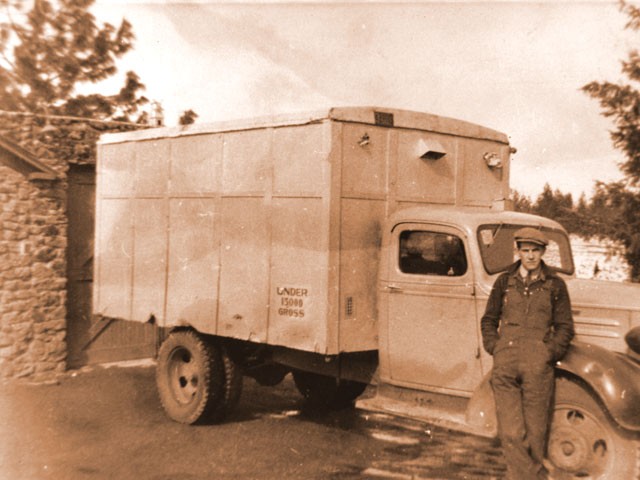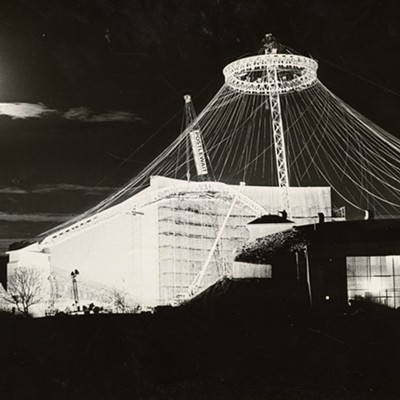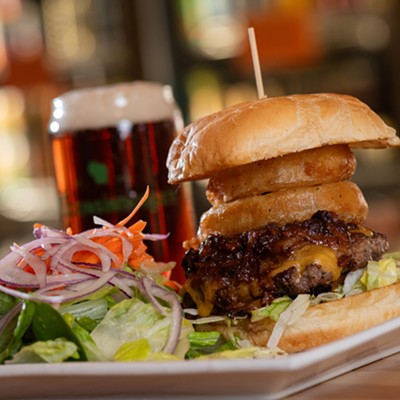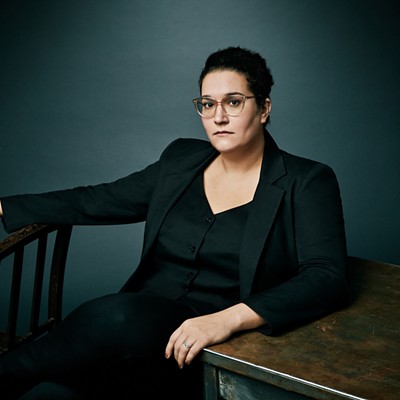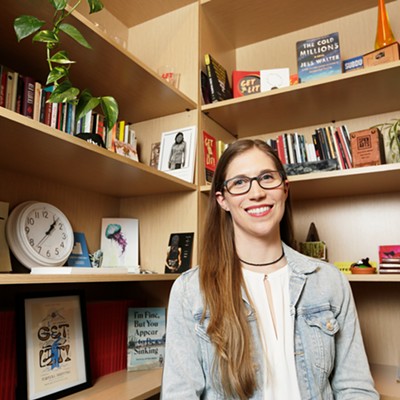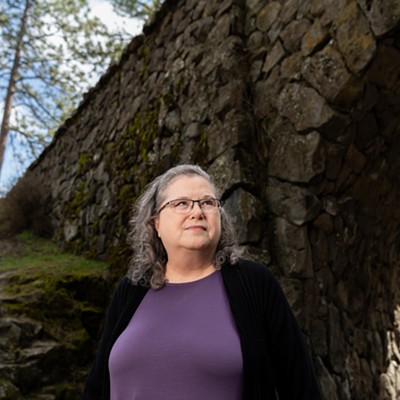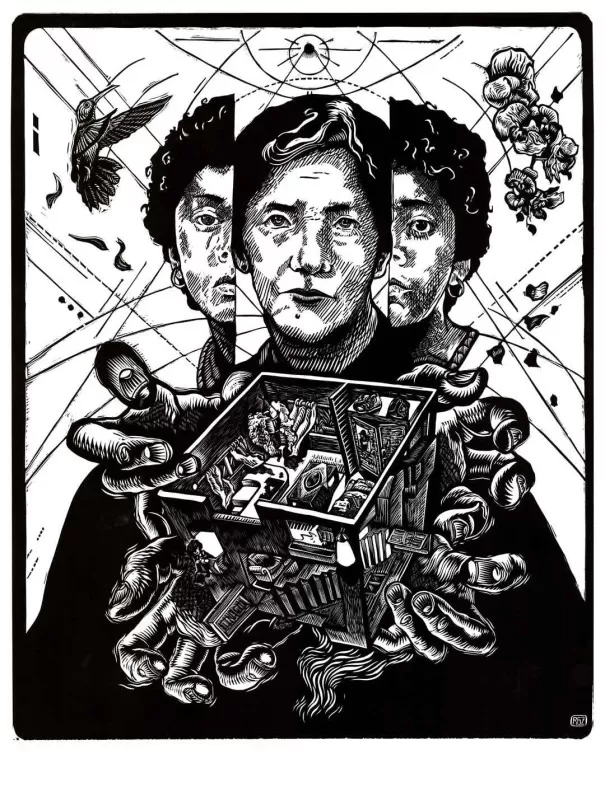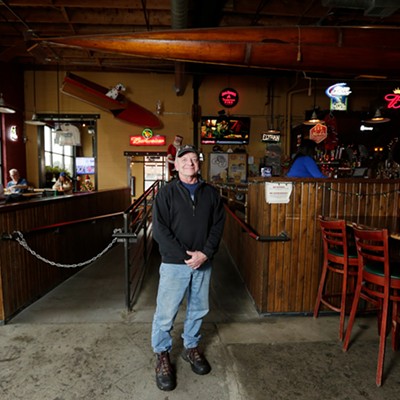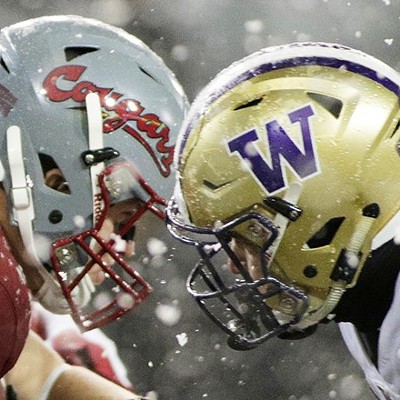Somehow, young Joe Peirone got a truck. They weren’t easy to come by smack in the middle of the Great Depression, but just a few years after graduating from Lewis and Clark High in 1934, Joe managed to grab a foothold on life that could haul a couple tons. In those days, a truck was the difference between the bread lines and pulling your own weight.
In an early entrepreneurial burst, with just enough cash hoarded to make a play, he grabbed his brother-in-law Frank and made a trip that might have gone something like this:
Joe had heard about a little cherry orchard down outside Lewiston, so they set out one July morning, navigating the harrowing 65 switchbacks down the Lewiston Grade. The grower pointed to the boxes and ladders; it was up to Joe and Frank to pick and pack their crop.
Passing through the rolling Palouse on the way home, their precious cargo filled the road ahead with American Dreams getting more plausible by the mile.
Joe was in the driver’s seat of a going concern.
Up in Spokane, in the wholesale district along Stevens Street between First and Second, they pulled the truck into a spot as close as they could get to the action. First thing in the morning, grocers from all over the city would shop along produce row to fill their stores. Joe and Frank unloaded their scarlet booty and set up a little display on the sidewalk — Joe handed out samples, saying, “Yes, sir, what we have here today are the first cherries of the season.”
Box by box, dollar by dollar, the truck emptied out. They sold the last lots to the fruit wholesalers next door at a discount — those cherries wouldn’t last forever. Like his dad always said, the produce business is a race against time.
After three days away, Joe pulled into the driveway of his two-room house late that night; the rattle of his truck woke his new young wife, Alice. She found him in standing in the kitchen — a flat of beautiful red cherries on the counter, a wad of cash next to it, a weary grin on Joe’s face. They laughed at the improbability of it all until the tears came. They ate those cherries till their stomachs ached.
That fruit never tasted sweeter.
That Lewiston run was just the beginning for Joe Peirone. A few years later, he founded Peirone Produce, and now, 65 years after that, his firm is expanding and moving into one of the nation’s most high-tech produce distribution centers — triple the space it currently occupies.
Joe, who passed away in 1992, a few years after selling his company to Spokane’s URM, would be proud of the new building — he’d want to see the plans to make sure they’d be taking proper care of the bananas and tomatoes.
Lots of businesses expand, build new headquarters, launch new products; Joe’s story isn’t so different. But Joe’s life is evocative of so many of the people who survived the Great Depression and helped build the Inland Northwest and enable this unprecedented quality of life.
We owe it to them not to forget what they did.
People like Joe — people who generally minded their own business and kept their heads down working — people like that never get much notice in newspaper stories. I’ve always thought that was a shame. So here we are, putting Joe’s life in the newspaper.
I hope Joe’s life resonates with you. It’s inspiring to remember that small dreams like his can grow — and even help launch new ones.
Yes, I knew Joe Peirone. To me, he was always just “Grandpa.”
Dominic’s Journey
To really get to know Joe, first you have to meet his father, Dominic. Joe’s opportunities, slim as they might have been in the mid-1930s, came on the power of his father Dominic’s determination. Facing a lack of opportunity in a nation seemingly adrift, Dominic became one of 9 million Italians who emigrated to America between the 1870s and 1920s. In early 1903, Dominic left his family home in Rifreddo, Italy — a village nestled along the foothills of the western Alps, closer to Marseilles than Rome.
According to the Ellis Island Archives, Dominic arrived at the Port of New York on March 10, 1903. Apparently, he made the journey with friends, as there were four other men from Rifreddo listed on the manifest for the 1,100-passenger Le Bretagne.
In those days, you needed a sponsor to immigrate, and the boys from Rifreddo had some kind of Italian brethren in Mellen, Wisc., so they set out for northern Wisconsin. Dominic was 23 years old and didn’t speak English.
Today Mellen has fewer than 1,000 residents, and Dominic worked building furniture there for a time, but he didn’t stay long. Family anecdotes have it that after a night too close to 60 degrees below zero outside his door, he decided to move West.
In those days, capitalists had lots of great notions that took lots of manpower to pull off. A big one was starting right around the time Dominic was looking to improve his lot — in north central Idaho, the newly incorporated Potlatch Corporation was building the biggest sawmill in the world just downstream from the biggest stand of white pine on the planet.
By 1905, he could have ridden either the Great Northern or the Northern Pacific; both lines had their eastern terminus in the Twin Cities. But it seems certain that on his way out to Potlatch, he passed through Spokane. While switching trains, he would have seen a bustling city feeding the labor needs of the mines, the farms and the timber mills. If he looked closer, he might have appreciated the crowning cliffs of basalt and the fertile valley he passed through just before pulling into the station.
Potlatch was to be one of those planned work communities — a place on the other end of the spectrum from the ramshackle work camps that usually sprang up around the latest exercise in natural resource extraction. Maybe it was too many men or too rigid a world, with company stores not quite living up to Dominic’s vision of American freedom.
Whatever the reason, Dominic left Potlatch to put down deeper roots in that nice little city he saw on his way out west. He’d settle in Spokane.
Homebuilding
By the late 1900s, perhaps with money he saved from his days at the mill, Dominic bought a little piece of land in west central Spokane.
In Spokane, Dominic tapped into skills he learned in Italy and started working as a stonemason. Using local basalt, he created birdbaths he’d sell at Manito Park on the weekends; he also did rockwork for some of those fancy new mansions going up on the South Hill. In his off hours, he built a brand-new house of his own at 2008 W. Carlisle Ave. (now torn down to make way for Audubon Elementary).
But his house was not a home yet. To finish the job, Dominic would need to get back on that transcontinental railroad.
Across the sea, Dominic, now 29, might have handed out Wrigley’s or some other proof of America upon his return to Rifreddo. He’d have certainly worn his best, wanting to show that, eight years in, this adventure was agreeing with him.
After greeting the family and answering questions from visitors all over the valley, he met her. The girl he remembered only as a shy 9-year-old was all grown up now — and betrothed to him. His letters must have been convincing, as Dominic and his parents won the consent of Caterina’s parents.
Caterina was 17 years old.
The newlyweds retraced Dominic’s original path back to Spokane and moved into their new home in the summer of 1911. After the whirlwind subsided and Dominic was back to work, Caterina sat alone and cried — this she told me when she was in her 80s and I was a teenager. She couldn’t speak the language; other young wives laughed at her, and the shopkeepers cheated her. She missed home. But after the tears ran out, she set her mind to making something of their new life in America.
It wasn’t long before the couple moved to a lightly settled area in Garden Springs, west of downtown, where they could have gardens, like back home. You can still see the family homes, built by Dominic, out there on Lawton Road.
Soon there were kids on the way — little Clara was born and then, on Jan. 15, 1915, along came Guiseppe Pietro Peirone. That was his proper Italian name, but as a natural-born American, they’d call him Joe.
Brand New Deal
For the growing Peirone family — little brothers Henry and Julius and sister Mary came along after Joe — farming was a way of life, just as it was for their relatives back in Italy.
“My grandfather had huge truck gardens,” recalls Jeanne, Joe’s daughter (and my mom). She remembers the elaborate rows of vegetables the family would harvest and sell at markets in Spokane. “They made a living off their gardens up there. I remember my grandma got up at 3:30 in the morning to work in the gardens in the summertime.”
So it’s no surprise that when the time came to strike out on his own, Joe stuck to what he knew — buying and selling fruits and vegetables. But the 1930s weren’t an auspicious time to enter the workforce. Like the rest of the world, Spokane was suffering under the ravages of the Great Depression; unemployment was around 25 percent, but that didn’t stop trainloads of drifters from coming to the city to look for work. They were called drifters because if they couldn’t find work in a month, Spokane ordinances required them to move on.
So it must have seemed unlikely, indeed, at the moment when Joe kicked the tires on that first truck, that he would take the produce business to a whole new level.
But first Joe became a trucker, hauling for the outfits down around the Stevens Street warehouse district. In the summer, he’d be running to Wenatchee; in the winter, he’d head for California. Most of the produce guys took their meals at the Silver Inn across the street from the warehouses (not to be confused with the swankier Silver Grill, a block away inside the Hotel Spokane).
Joe liked more than the weak coffee — one waitress caught his eye, and an extravagant tip turned into a brief courtship. He and Alice were married in June 1938; she was 18. (Alice is still with us today, at 91.)
It probably didn’t take long for Joe to notice that the job to have in the produce world was wholesaler — the middleman between the buyer and the seller. Getting that first truck was a start, and the Lewiston run proved he could do it, but could he do it on a daily basis?
In late 1944, he got a chance to find out when he took over New Deal Produce — one of the lesser players in the wholesale district, but still, a fixture there since 1934. Peirone Produce got off to a humble start — in fact, it barely had a business address. That first warehouse was located at 171 S. Stevens, and Bud Skredzvig laughs when asked what it was like. Bud, now 87, joined the business in 1946 and was Joe’s right-hand man (and near-daily lunch companion) for the rest of his career.
“It wasn’t what you would think of as an office,” says Bud. “It was along the back wall of a filling station there on Stevens. There was a ramp that went down into a little garage. That was it.”
But it was a start.
Trial and Error
Joe was drafted in May 1945, just as the War in Europe was ending. Maybe it was his flat feet or his two kids and a business, but he was never inducted. Instead, he got to work, meeting growers and grocers and making friends around the neighborhood — there was Archie, the new proprietor of Sanders Market a block away over on Washington Street (where Saunders Cheese Market is located today).
At this time, grocers often had to track down items on their own, with chaotic pricing to match. Grocers couldn’t put up with the uncertainty and the hassle; the produce business needed to change.
Those were days of trial and error — lots of error, recalls Bud Skredzvig.
“There were lots of times when Joe was broke and he knew it, but he wouldn’t admit it,” recalls Bud. “Jean [Bud’s wife, and the company bookkeeper], she’d get out the payables — they had a stack of the damn things — and they’d decide which they could pay now and which they would have to borrow on.”
Joe himself recalled those times in a 1982 article in the industry newspaper The Packer: “We borrowed and borrowed again from the banks,” Joe said. “It was hard to put enough money together to get business against the established companies.”
Bud says it went beyond the banks — Joe borrowed money from Archie, the grocer up the street; he even took a loan from one of his own employees who had saved up a little.
“He had some mighty rough times getting going,” says Bud, adding that Joe always paid back every cent he borrowed. And later, when the company got on solid footing, Joe paid every bill within a week.
For Joe, work and family were always combined, which brought its own complications. “Joe sure put up with a lot,” Bud says.
But Joe needed any help he could get, and family stuck together. Frank Pignanelli, who was married to Joe’s older sister Clara and was there for that first trip to Lewiston, slipped in and out of Peirone Produce. But he did finish his working life there in remarkable fashion: For more than 30 years, Frank babysat the bananas — checking their temperature and ripeness twice a day, six days a week. He followed the routine until he was 94 years old.
Joe’s younger brother Julius was a buyer, brother-in-law Fain worked on the trucks, and his son, Jim, first went to work at the warehouse when he was 10 years old, ultimately holding pretty much every job Peirone Produce had to offer. Even Dominic worked there until he was 75, just a year before he passed away.
Oddly enough, a swipe of a bureaucrat’s pen brought the next big change to the produce business. Sometime in 1950, Bud recalls, Second Avenue was turned into a one-way street. This made it impossible to turn trucks around to get into the Stevens Street wholesale district. It’s as vacant today as it quickly became then — only a lone brick building remains in a sea of parking lots, just across the street from Allied Security.
A Fresh Start
The next brilliant step was to co-locate all the produce companies under one roof — to replicate the bustle of Stevens Street, with better access and high hopes. It was almost an instant disaster.
The Produce Terminal, on Ide Street just along the north side of the Monroe Street Bridge, tried to recreate a past that wasn’t really working. Grocers didn’t show up to buy direct — they wanted deliveries, and the smart companies would need to accommodate them. It was also a bit of a den of thieves — too many people, too much temptation to pilfer. It reminded Joe of the centralized produce market he visited in Chicago, riddled with organized crime. And pricing got so cutthroat, nobody could actually make any money.
It took them until 1953, but they got out of the Produce Terminal as quickly as they could.
Their next stop wasn’t exactly what you’d call fancy, but it would give them plenty of space to store produce, to load and unload their growing fleet of trucks and, best of all, it was far away from their competition. They moved into the shuttered Golden Age Brewery, which had been the Schade Brewery way back and the Hotel De Gink during the Depression. It’s still standing today, looming high above the growing University District east of downtown Spokane.
This was the time Peirone Produce started turning the corner. Bud and Joe would travel to Tacoma to see how Pacific Coast Fruit did it. It was all about inventory control, Bud recalls the epiphany. They adopted several practices they saw the following Monday morning.
This is where the frugality born in the Great Depression came in handy. Nothing went to waste — bins of potatoes were sorted to save the few that still had shelf-life in them, and they hired their own mechanics to maintain their growing fleet of trucks. (This was an ethic deeply ingrained; I remember dropping by to visit Joe and Alice one weeknight to see them sitting down to a meal of chicken necks.)
It was also a time to solidify the relationships that made his business run. Despite still being the smaller, underdog shop, he worked to win new business. He had his eye on one go-getter in particular — Mert Rosauer, who had opened Spokane’s first-ever “super” market in 1949 at Third and Oak (where the Browne’s Addition Rosauers still stands).
Forging Ties To Last
Starting in the summer of 1952, Joe moved the family to Fresno for two months each summer. That arrangement, under the baking Fresno sun, continued for seven summers. Joe spent his days in the fields of central California with the growers who would supply him with tomatoes, cantaloupes, lettuce and so much more. He had gotten to know the apple growers and others around the Northwest during his days driving a truck; he needed to know these people, too. His business depended on California. Many became more than business partners — they became his lifelong friends.
During the mid-1950s, Joe and Alice settled into family life. They added on to the two-room house his father had given him; he planted a cherry and apple orchard in the field between his house and his parents’, and he built a greenhouse so he could grow starts in the winter to plant his own geraniums around the yard come springtime. They didn’t travel much — they never did get over to Rifreddo.
Joe was pretty much always on the job, working six days a week, recalls Jeanne: “I think my dad really had a lot of stress. He’d get phone calls from the truck drivers at all hours, letting him know they had a problem, or that they spilled a truck somewhere.”
But in 1956 he did buy a cabin on Lake Coeur d’Alene. For years after that, Joe and Alice spent most of the free time they had out there.
Times were changing quickly by the 1950s. Jim Peirone remembers the day in 1958 when Peirone Produce’s very first self-contained refrigerated trailer rolled onto the lot.
“You always had to worry about perishables,” Jim says. “That was always critical. And the early trucks didn’t have much insulation. They had an ice bunker, with ten 300-pound blocks of ice, and a blower. You always had to unload the trucks right when you got them.”
This gleaming new Freightliner was a game-changer.
Meanwhile, Joe’s old friend Mert was going gangbusters. After some discussions, Joe and Mert shook hands in 1961 and struck a deal that would bind the two companies for the next 50 years. Peirone Produce would be the exclusive supplier to Rosauers supermarkets, but they would have to deliver to wherever they expanded — a deal that would ultimately send Peirone Produce trucks well into Montana.
Joe got what he’d always worked for; now he just had to keep up with his success.
Just Like Family
In December 1965, just 100 yards from their location in the old brewery, Peirone Produce opened its new, then-state-of-the-art, 23,000-square-foot warehouse — built almost identically to the plan used by Pacific Coast Fruit in Tacoma.
Jim Peirone remembers the 20 years that followed as the time when the team really dialed things in.
“We all worked together, and we were very, very successful at it,” says Jim. “It was a very, very good business, and a great career for lots of people.”
I walked into this scene one summer morning in 1978. Joey Rubino handed me a broom and I was off, at age 15, to the first of nine summers working in the warehouse, doing everything from sorting potatoes to unloading banana trucks. Once I turned 18, I even joined the union and became a Teamster.
Joey was the merry prankster of the team and just one of the many Italians who worked at Peirone’s. There was Leo Dieni, Ernie Fruci — it was kind of Little Italy. (For the record, “Peirone” rhymes with “phone”; under no circumstances were you ever to pronounce it like “Peironi.” Maybe sounding too Italian was still a sore subject for Joe, having grown up Italian in a town run by the Irish.)
Ultimately, Peirone Produce allowed some long-timers of Irish descent — guys like Bob Casey and Pat Fitzpatrick, who started at age 17 and is still with the firm today.
Any business is only as successful as its people allow it to be, and Peirone Produce has always been powered by the people who worked there — and who work there still.
“There was damn little turnover,” says Jim Peirone. “Everybody was treated like family.”
I still think about how important it was for me to learn how to put my head down and just get a job done — and I learned to work from some of the best.
“It was the definition of honest work,” says my brother Jer, who also worked at the warehouse during the summertime. “The people I worked with worked hard, and being Joe’s grandson, I had to work hard, too. I learned that work ethic, and I got to be around a functioning business and see that it takes everyone doing their part.”
Bigger Than Ever
By the 1980s, Joe and his team had succeeded in bringing the produce business into the modern era, creating order where there had been chaos. They helped solve a basic need of modern life — getting good food onto people’s tables. But things would change yet again. In 1984, URM bought Rosauers, putting the longstanding handshake deal into question. United Retail Merchants has an even longer history than either Rosauers or Peirone, as it was founded by local folks in 1921 right here in Spokane; URM’s founders had to overcome the same kinds of struggles as Joe and Mert.
By 1986 a deal had been struck, and Joe sold his company to URM; he stayed on for another year to help ease the transition. (When Jim Peirone retired in 1998, he was the last Peirone on the job.)
During that transition year, Joe trained URM’s man, Pat Davidson, who remains the president and CEO at Peirone Produce. One early decision was to keep the name.
“What Peirone Produce had in place was probably the finest reputation in the industry,” says Davidson. “It was very, very important to me that we maintain that name and the image associated with that name. It’s still the same company as it was 40 years ago when Joe was building it.”
In this era with growing recognition of the importance of strong local economies, it’s worth remembering that some of the oldest names in town — URM, Rosauers, Peirone Produce — are all homegrown success stories that continue today.
“I’m so proud of the fact that the name lingers on,” says Jeanne. “My dad worked so hard for so many years.”
And now it’s time to move again, and you can blame the traffic, as when Peirone had to move from Stevens Street back in 1950. Their current building, on land owned by Washington State University, is getting squeezed out by plans to expand the University District and extend Riverside Avenue. Then there’s the fact that they’re bursting at the seams, with 100 employees, 40 trucks and a product line that seems to be growing every day, featuring bagged lettuce and other exotic items only dreamed of in Joe’s day. The new facility, located on Hallett Road off I-90 on the West Plains, will be almost triple the size of their current space.
“The new facility is absolutely state-of-the-art,” says Davidson, “with all of the latest technology that’s available for refrigeration. It’s the newest produce distribution building on the West Coast.”
They’ll start moving in next week, 107 years to the month after Dominic Peirone set eyes on the Statue of Liberty and had to wonder how it would all turn out.
Helping Hands
What can we learn by digging into family history? Of course it’s humbling to learn more about the sacrifices that gave enabled our lives today. And now that my brother Jer and I have a business together, it all makes more sense. I think I have a pretty good idea of how hard it was for Joe.
But as I dug into my grandfather’s life, I found something else — a common thread. At crucial moments throughout the story, people took risks to help each other when they needed it most. Everything hinges on the faith of family and the kindness of friends, and that’s something we all need to remember as we live our own lives.
How did poor, young Dominic afford passage to America all those years ago? When my mom and dad visited Rifreddo, they learned something new: A generous aunt loaned him the money to start a new life.
Where did Joe, a kid from a poor immigrant family, get the money to buy that first truck? There’s no record or story, but it seems likely that his dad helped him with a down payment. Then, during his leanest years, Joe only stayed in business by borrowing from friends. His friend Mert Rosauer even took out a loan from his own parents to launch his dream in 1934.
When we were ready to start The Inlander, we followed in that long tradition. We needed help, and by help we meant money. And we were asking for a lot of money to risk on what might rightly be described as a hare-brained scheme — to start a second newspaper… in Spokane! (We found out later this was essentially the line of reasoning an adviser used to argue against our loan request.)
I had a sketch of a business plan, but the day I nervously presented it, my prospective lender didn’t even bother to look at it. She answered my awkward pitch without a moment’s hesitation: “Of course.”
Soon I had a cashier’s check in my hand. The signature at the bottom of that check? Alice J. Peirone.
That was in 1993, only a year after Joe had passed away. Our first issue came out a few months later; Joe just missed it.
And when Jer (whose first name is “Joseph”) says, “There is no Inlander without Peirone Produce,” he means that our debt goes well beyond that seed money. Of course we owe even more to our parents, but I like to think that the lessons of Joe’s life rubbed off on us, too — the raw stubbornness and hard work it took to build his company; the personal touch that fueled his success; the crucial need to surround himself with the best people he could find to make it all work.
Again, I hope this story resonates with everyone as a snapshot of old Spokane, but for me, well… I guess it’s been another way to say something pretty simple.
Thanks, Grandpa.
OUT BEHIND SANDERS MARKET
Since the cavemen first gazed up at the stars, we’ve all been yearning to know where we came from, why we’re here and where it’s all going. Genealogy is such an obsession because it tackles these mysteries in ways that touch our souls.
We experience the world through our own eyes; all history is personal. And as I walked around the old neighborhood down on Stevens Street, where so much of this story happened, I was feeling those existential pangs.
Remember Archie? Joe’s friend who ran Sanders Market just a block from Peirone Produce back in the 1940s? Well, I left something out about him. I didn’t mention his last name.
It was McGregor.
Years after they were neighbors, one summer day in 1961, Joe stopped by his old friend Archie’s new store in Coeur d’Alene (at the old Lakeview Court across from the City Park). Joe had his daughter Jeanne with him. Archie’s son, Ted, was home from college working in his dad’s store that day.
Of course my mom and dad still remember seeing each other for the first time. There was a phone call, then a date. A few years after that, Ted McGregor added the “Sr.” to his name.
So I’m here today, able to pour this story into my computer and onto these pages, because my two grandfathers went into business a block away from each other.
As I stood out in the alley behind the old Sanders Market, I looked straight up into the same sky they toiled under. I thought of Joe turning his truck onto Stevens after that first run down to Lewiston for cherries. I pictured Archie flipping the sign on his front window to “closed” after his first day at Sanders, only months after getting back from his tour of duty in the Pacific. I imagined Joe and Archie sharing a beer some night before heading home to their families, talking about nothing in particular.
As I looked back down, it was 2010 again, but my feet felt heavier somehow — almost rooted into the ground below. — Ted S. McGregor Jr.

